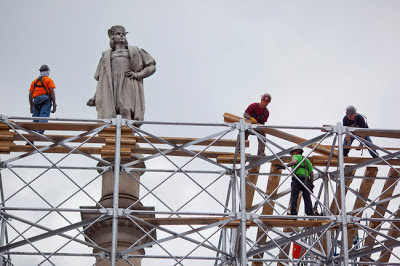 |
| photo: Jesse Hamerman |
Nothing in Nishi’s work is expected to address that issue. His focus is on visual surprise and creation of surreal experience for visitors, who will be able to commune face to face in homey comfort with the 120-year old and 13-foot tall explorer sculpture as it perches on the table surrounded by couches, a bookcase and TV with the grand views of central park from the windows.
Nishi's interest in collapsing the wall between private and public spaces goes back to his teens day when he saw Shuji Terayama film Pastoral: To Die in the Country in which a set of a taditional Japanese house suddenly collapses, revealing that the interior space had been built on the bustling street of Shinjuku, Tokyo's entertainment and shopping district.
Born Tatsuro Nishino in 1960, he graduated from the painting department of Musashino Art University in 1984 and left to Germany in 1987, where he worked in the shushi restaurant in Düsseldorf until he joined Academy of Fine Arts in Münster to study sculpture. In the interview for ArtAsia Pacific (September&October issue) he tells Hanae Ko that he became interested in studying art in Germany after befriending Japanese student from Düsseldorf Art Academy who introduced him to its liberal education system different from Japan's conservative and technique-based. Lacking founds, he used sushi restaurant's storage room as a makeshift studio, where he created installations incorporating garbage from the kitchen to build his portfolio. Though his application was rejected the first year, the following year, in 1989, he was accepted at Academy of Fine Arts Münster (AFAM).
During my final year as a student in AFAM, I began to produce works that captured familiar objects in a different light from how they are normally seen. By not making any changes to the object but instead changing the environment in which it is viewed, I was trying to show the unexpected characteristics of an object that often go undiscovered. Around that time, Nishi also changed his stance as to how artworks should be exhibited. I had a show at the gallery in Cologne, but because there were few visitors, I become skeptical of the gallery's role and effectiveness as an exhibition space. It was then that I sought a more accessible outdoor venue where I could show my works to the general public. Nishi first installation in the public space was a square room that encased Der Tauzieher, a large stone sculpture of a man sitting atop a mooring post which stands in the former commercial area in Cologne.
In his long experience with official monuments in the cities around the world, Nishi believes that these objects often suffer an unfortunate fate. When the monuments are first unveiled, they attract attention to be soon forgotten and melt into the local scenery. For me what is interesting about these monuments is not their history or design, but the fact that, despite being very visibly displayed in public, they fail to register in people's minds.
 |
| photo: Robert Caplin |
Born Tatsuro Nishino in 1960, he graduated from the painting department of Musashino Art University in 1984 and left to Germany in 1987, where he worked in the shushi restaurant in Düsseldorf until he joined Academy of Fine Arts in Münster to study sculpture. In the interview for ArtAsia Pacific (September&October issue) he tells Hanae Ko that he became interested in studying art in Germany after befriending Japanese student from Düsseldorf Art Academy who introduced him to its liberal education system different from Japan's conservative and technique-based. Lacking founds, he used sushi restaurant's storage room as a makeshift studio, where he created installations incorporating garbage from the kitchen to build his portfolio. Though his application was rejected the first year, the following year, in 1989, he was accepted at Academy of Fine Arts Münster (AFAM).
During my final year as a student in AFAM, I began to produce works that captured familiar objects in a different light from how they are normally seen. By not making any changes to the object but instead changing the environment in which it is viewed, I was trying to show the unexpected characteristics of an object that often go undiscovered. Around that time, Nishi also changed his stance as to how artworks should be exhibited. I had a show at the gallery in Cologne, but because there were few visitors, I become skeptical of the gallery's role and effectiveness as an exhibition space. It was then that I sought a more accessible outdoor venue where I could show my works to the general public. Nishi first installation in the public space was a square room that encased Der Tauzieher, a large stone sculpture of a man sitting atop a mooring post which stands in the former commercial area in Cologne.
In his long experience with official monuments in the cities around the world, Nishi believes that these objects often suffer an unfortunate fate. When the monuments are first unveiled, they attract attention to be soon forgotten and melt into the local scenery. For me what is interesting about these monuments is not their history or design, but the fact that, despite being very visibly displayed in public, they fail to register in people's minds.

No comments:
Post a Comment